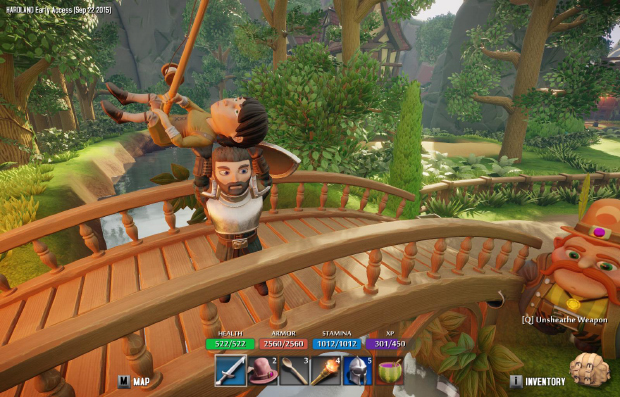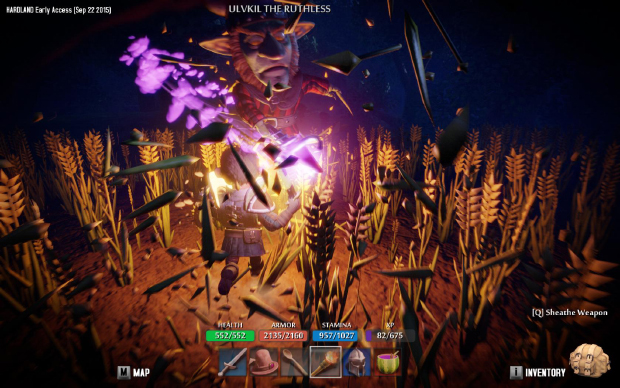Premature Evaluation: Hardland
Walky-Porky
Each week Marsh Davies gambols through the lush pastures of Early Access and comes back with any stories he can find and/or feeds some ham to a decapitated skeleton while dressed as a chicken. This week he’s been playing Hardland, an unusually gorgeous and imaginative ARPG set in a part-procedural bucolia of rolling hills and haunted forests.
Having no head, much less a stomach, it’s not wholly clear how the skeleton intends to eat the ham he’s begged me to fetch. But there he is, standing by the river in his oversized pauldrons, optimistically holding a saucepan, issuing dying wishes to passing chicken-headed men. As undying wishes go, though, to taste ham one last time is relatively benign and, the difficulties of his digestion aside, my part in this quest is trivial to fulfill. When I give him some ham, after several minutes of pelting round, waving my sword at pigs, the skeleton rewards me with a mask. A pig mask, in fact, which, much like the chicken mask I am currently wearing, successfully disguises me as the animal in question, allowing me to charm and, supposedly, command them, possibly in great numbers.
I haven’t yet worked out how to do this in my too-brief time with the game: it abruptly ceased working overnight, affording me only a few hours play in total. Mountain Sheep are a small dev studio and although they are very responsive by the standards of Early Access, a patch to fix the game might take them a week to issue. Hardland is, by their estimations, 65% complete, and it feels it: chaotic and a little glitchy, with nothing in the way of an explanation for your purpose or really any of the game’s systems. But those short few hours have also shown me a game which has been as continuously surprising as any RPG I’ve played, mixing pre-authored quests and discreet, designed areas with procedurally generated wilderness, busy with strange characters doing their own emergently chaotic things. It’s weird, funny and full of personality - its art-style alone is one of the most winsomely idiosyncratic since Windwaker, with the bobble-headed, wide-eyed characters having the soft, tactile look of clay sculptures, as though from some 80s Eastern European stop-motion animation. It’s cute and mischievously grotesque, and delights in juxtaposing the two. I love it.
If you were somehow rendered insensible to Hardland’s astonishing art-style, however, the game doesn’t otherwise immediately promise to upset expectations: you awake an amnesiac and are quickly given directions to a nearby village by a fisherman, who inevitably slips in a fetch-quest for a new rod. But you can step off this path almost immediately, abandoning the primly designed wooded enclosure for a sprawling procedural landscape by way of a giant glowing portal, over which hovers the tool-tip “WTF”. I step through, finding myself on an outcrop of rock, littered with skulls, overlooking rolling hills and forests. A nearby tree grows oversized apples and I fall off the outcrop as I take a swing at them, tumbling into a congregation of chickens, who, I infer, are worshipping at an altar. On it sits a chicken helm. That’s mine, I think, and take it, pelting away from the angry squawks that ensue and into the woods.
Zombies muddle about aimlessly here, but don’t seem instantly aggressive. I take a swing at a few anyway, which appears to rile up the ones closest to me, but I’m nimble enough to avoid their slovenly flailing, and put them to the sword, admiring both the precise and responsive collision detection and the voluminous gouts of fuscia blood that squirt out of them. Night sets, momentarily leaving me in the pitch dark before the moon climbs into the sky. Torches move in the distance and I work my way closer, towards a copse of trees which surround a house. Gunshots resound, though I can’t make out who is responsible. The torchbearers are a goblin troupe of varying sizes. The largest are clearly captains, each given unique names and armaments, while the smallest are disposable minions - but adorably miniature, like the innermost matryoshka doll. Some spot me, and come waddling through the grass. I take a few swipes, sending the little goblins (goblets?) flying like skittles. But, now suddenly appreciating their numbers, I decide on a course of discretion and leg-it back to the portal. Starter Village Quest it is.
Even this holds a fair few surprises. As dawn rises again, the guards by the village gate are drawn into combat with a sizeable force of zombies, led by a ghoul - I join in, but in the chaos somehow manage to aggro both the guards and a nearby merchant, who blunderbusses me. I’m not sure how permanent such states of aggression are, but it’s clearly a good idea to save regularly. Luckily I have, and undo my misdeeds, sauntering on into the village. A tiny wizened old man with a large round nose tells me, “I often eat cabbages.” I pick him up and throw him in a river. It turns out you pick up a lot of things, including people, and throw them into rivers. I really enjoy this. Other characters have more useful things to say and offer fetch-quests, too - thereby forestalling their rivery fate. None of these quests seem to suggest a larger narrative or particular centrality as yet. I find a fire-mage’s hat stuck in a tree and return it to him. I pick up the fisherman’s new rod from the blacksmith. I give an old lady some apples. But as mundane as some of this might sound, the art style’s ability to balance on the very dividing line between cute and sinister renders it with a giddy unease.
Things take a more definitive turn when I meet the mayor. He seems peaceable enough, though surrounded by a cluster of guards and a suspiciously well-armed elf. We have a brief and not terribly enlightening chat about the village, and then, while experimenting with my inventory nearby, I somehow enrage everyone by donning my chicken helm. Panicked, I run, leading them in an angry conga line round the ornamental gardens of the mayor’s manor. Each of my pursuers has a unique name - although some of dubious accuracy: Terrence the Friend of Animals is clearly not that fond of chickens. And with good reason, it turns out: I kill him with a magic green mace I seem to have acquired from somewhere. I have some luck kiting the rest of them around hedges and tonking each as he emerges, but eventually the elf does me in with an arrow. All my loot fountains from my body as it crumples to the floor.
Masks don’t always inspire such aggression however - the pig mask, for instance, seems to let you go through both human and goblin country unmolested. After a reload, I go exploring, and briefly chat to Ulvkil the Ruthless about how fat and delicious the goblin king is looking these days, before chasing him through a corn field and bludgeoning him to death, sheafs flying with every blow. Later, I trade his heart for some healing potions at a witch’s cottage, before stumbling on into the procedural wilderness - it can be reached on foot as well as by portal, it seems. Here I encounter an undead merchant, who groans incoherently at me before being slain by a wandering elf. I follow this elf, known as The Swift Boot, apparently, as he carves a bloody path through the local fauna. He doesn’t seem terribly interested in the loot, so I snaffle it all up after he’s done the hard work. He eventually bites off more than he can chew, ploughing straight into a force of some twenty or thirty goblins, who are apparently guarding a house, sending wave after wave of mini-goblins flying, before falling before the blade of The Poison Tooth. Still wearing the expressionless, glassy-eyed pig-mask, I saunter up to pocket the elf’s goodies. The Poison Tooth remarks that he can’t wait until the fat goblin king bursts. I thwack him over the back of the head and take his hat.
Where am I going? I don’t know. The goblin king looks like a promising line of inquiry, but the game’s shape is hard to perceive and it lacks a clear sense of purpose to draw you through its content. But the systems that underpin its world are clearly rich and deep, and its incidental detail full of wit. I’m not exactly sure what the destiny of Hardland will be. With only a handful of developers, it may top out at a wonderful curiosity - a modest mixture of off-kilter caricatures, fetch quests and emergent chaos in a beautiful sandbox. But in my head it could be next Zelda or Fable: I so dearly want a game with this tone, art-direction and clever blend of procedural and pre-authored storytelling, yet with the megabudget of a triple-A title and the robust, polished expanse of content that this would permit. I wouldn’t normally put money on that happening, but when the consolation prize is already so delightful, it might just be a bet worth taking.
Hardland is available from Steam for £11. I played the version with the Build ID 784771 on 22/09/2015 and had a jolly good time.





